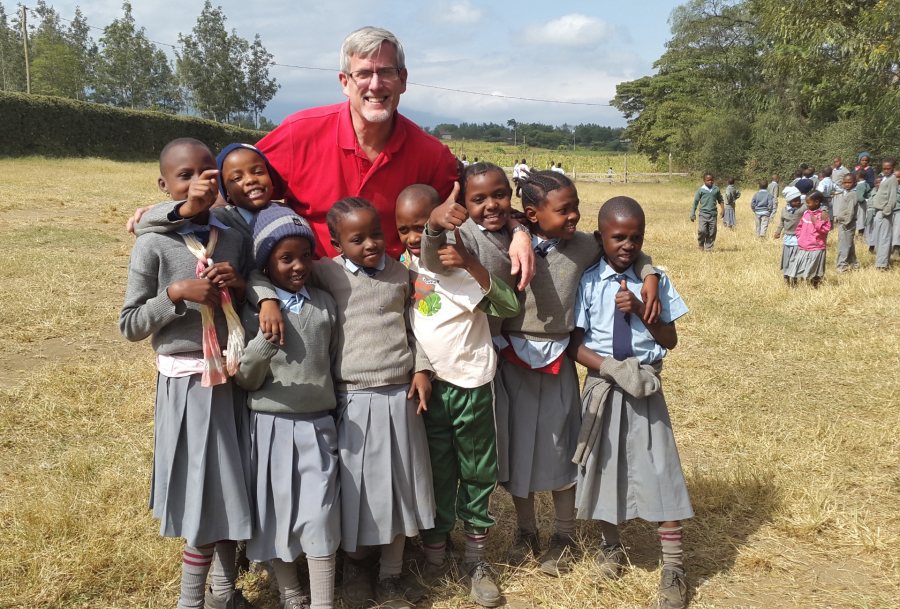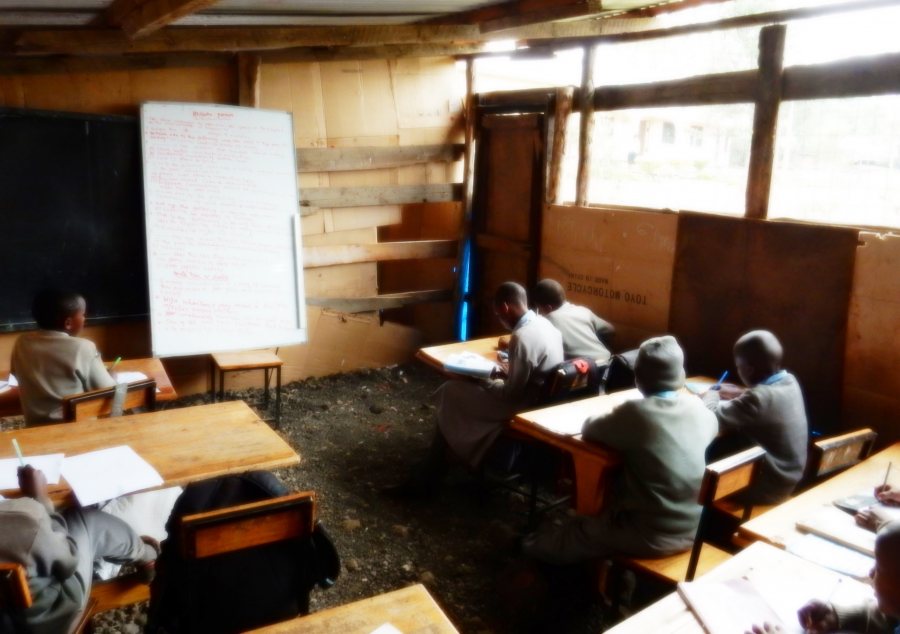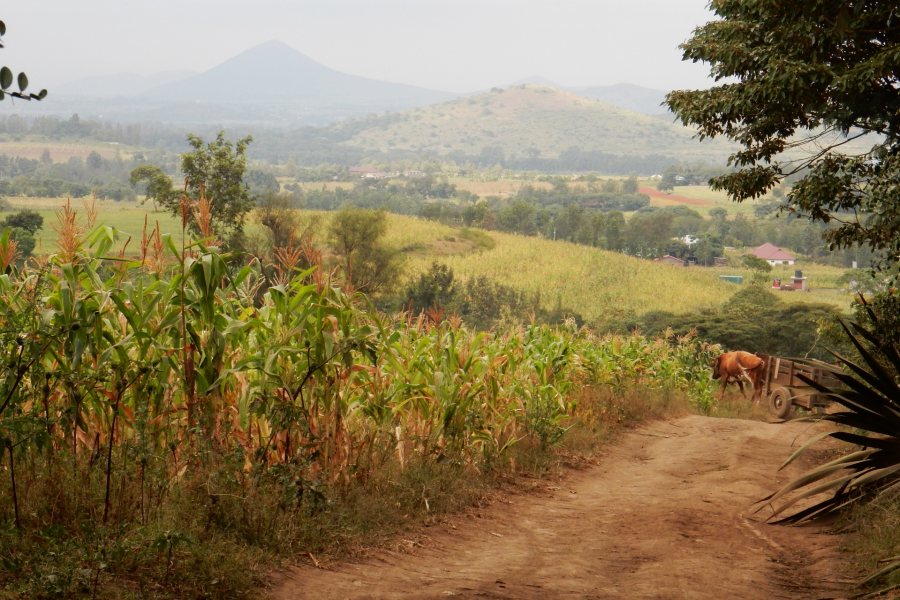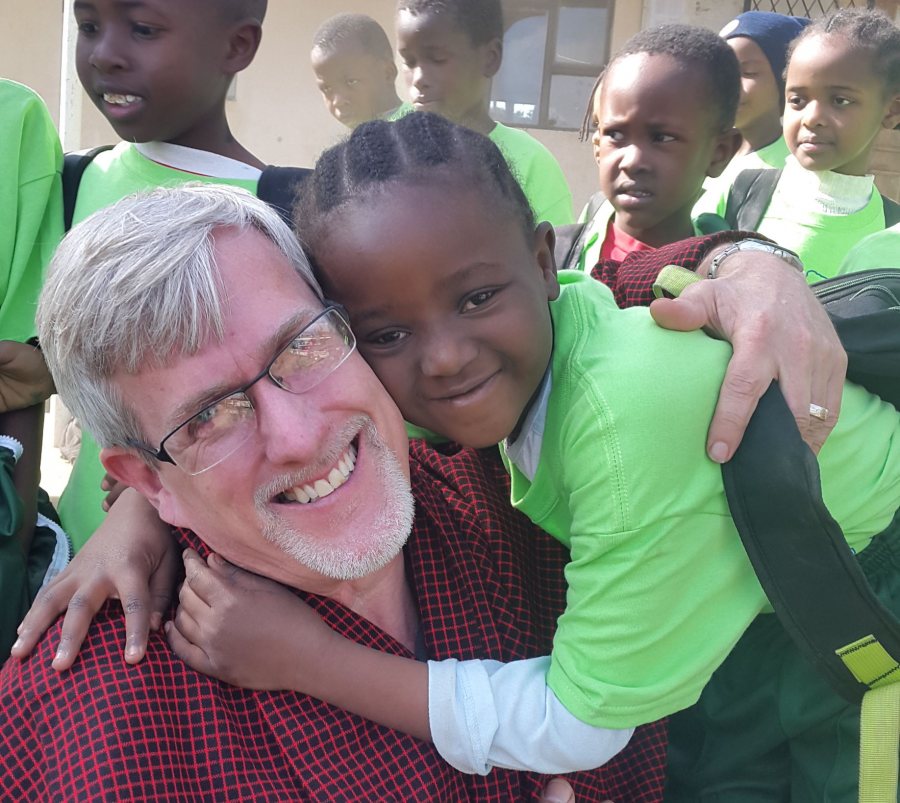2015 Barlow Travel Grant Report
By Bruce Fryer ’79
Background
The 2015 Barlow Grant funded my trip to Arusha, Tanzania, to volunteer teach at the Maasai Joy Children’s Centre. Maasai Joy is a K–7 primary school whose charter is to provide English-based education to local Maasai children. I selected Maasai Joy based upon the remarkable and noble story of its founder, Edward Ernest Kutingala. Ernest, a Maasai himself, found economic independence as a young adult by becoming a guide at nearby Mount Kilimanjaro. His reputation as a guide grew to the level that he was able to start his own expedition company, Kibu Expeditions. This economic independence fed a sincere desire to give back to his community, so Ernest shared his dream of establishing a Maasai primary school with several of his Kilimanjaro clients.

Bruce Fryer ’79, awarded a Barlow Alumni Travel Grant to teach at the the Maasai Joy Children’s Centre in Arusha, Tanzania, for two weeks in summer 2015, poses with some of his students during field day festivities. Photo courtesy of Bruce Fryer ’79.
The resulting collaboration, as well as proceeds from Kibu, gave birth to the Maasai Joy Children’s Centre. Without this education, these children would have few life options other than to live a life of poverty carrying on the cattle herding tradition of their ancestors. As the rest of the Tanzania society and economy continues to develop, land is becoming increasingly privatized and the Maasai communal way of life is becoming increasingly difficult.
After contacting Ernest via email, we arranged that I would volunteer during the weeks of July 27 and August 3.
My Arrival in Tanzania
I was met at the Kilimanjaro airport by Ernest and joined by a small group of travelers who had scheduled a seven-day Kilimanjaro climb beginning the next day. We all went to dinner at a nearby resort and nice opportunity to begin to get to know one another. It turns out that the group was led by a professor from the University of Rhode Island who would be joined a week later by a dozen more URI students for what had become an annual volunteer teaching experience. That night over dinner, I experienced my first power blackout, an unplanned event that would occur on an almost daily basis.
After dinner, we were driven to the Habari Lodge, a locally run hostel that would serve as our accommodations. The lodge was part of a gated complex of homes and buildings owned by small nonprofit organizations. What was perceived the first night as just basic accommodations became over time a very warm home base filled with a colorful cast of characters, from a contingent of women who worked for a worldwide Christian radio ministry to the students from URI.
Introduction to the Maasai Joy Children’s Centre
Ernest picked me up Friday morning and drove me to school so that I could have a tour and meet with the head of school, Christina, and her teaching staff. All were very warm and welcoming. The school was, by contrast to even American urban school standards quite stark. Classrooms lacked lights and the well-worn blackboards were more reminiscent of topographical maps than a writing surface. One classroom building resembled a chicken coop, complete with walls made from flattened cardboard boxes. The children, however, were blind to these limitations and could only see opportunity. They lit up each of the classrooms with their joy of learning.

The fifth-grade classroom at the Maasai Joy Children’s Centre, where Bruce Fryer ’79, funded by a Barlow Alumni Travel Grant, taught in summer 2015. Photo courtesy of Bruce Fryer ’79.
Christina and I arranged to meet the following morning in order to walk to school together. This became and almost daily ritual that both of us looked forward to. It was a special opportunity to ask questions about each other’s respective cultures, teaching experiences, and views on educational leadership.
In addition to great company, the two-mile walk through the countryside to school was stunning. The unpaved road begins in the middle of sunflower fields and ends with the opening vista of a beautiful and fertile valley that lies in the shadow of Mount Meru. Rural Tanzanian life unfolds between. Donkey drawn wooden carts amble down the road carrying corn or grain. Secondary school children scurry off to school in their maroon uniforms, as less fortunate children shepherd their goats to nearby grazing land or lead a water bottle-laden donkey to the local fresh water source.

A view from the twice-daily two-mile walk Bruce Fryer ’79 took to and from the Maasai Joy Children’s Centre in summer 2015. Photo courtesy of Bruce Fryer ’79.
Saturday Professional Development
I met the staff the next morning for a half-day teacher-training program. No one seemed concerned about giving up a Saturday morning in order to learn more about their craft. I broke the session into three modules: “Mindsets (based on the research of Carol Dweck)”, “6 Great Teacher Moves,” and “Lesson Planning for the 60-minute Block.”
The teachers are all non-native English speakers, and the difference in our respective dialects was an initial hurdle to communication. This made it difficult to encourage group participation. In response, I distributed write-on/wipe-off slates (a gift that I had brought with me). Participation rose and our ears slowly became better accustomed to the sound of each other’s voices.
My Teaching Experience
This is my 15th year of teaching, the last seven of which have been in the urban school district of Newark, N.J. Socioeconomically, my school is 98 percent black and more than 90 percent of students receive free or reduced lunch. It was this experience in working with so many African American students and families that inspired me to travel to Tanzania.
My journey to Tanzania and the Maasai Joy Children’s Centre began just 24 hours after the end of my school year. This had been my most challenging year of teaching, and I was emotionally tapped out. Fortunately, the contrast between schools and students could not have been greater. I was greeted each morning like royalty by students with a unified exclamation of “Good morning, teacha!” to which I would respond, “Good morning, students. How are you this morning?” “We are well, thank you,” they replied. At the end of one lesson, the second teacher led her class in a song of thanks: “Thank you, Mr. Bruce, for teaching us.” Another morning, I was met at the door by fifth-grade students who had arranged to greet me with a song whose lyrics include, “We love you so, so, so teacher Bruce. Teacher Bruce, we love you so.” This was going to be the perfect ending to a very difficult school year.
During the first week, I made myself available to teach any subject and grade that I was invited into, but I spent the most of my time with the sixth- and seventh-graders. I brought my tablet with me, which allowed me to infuse many of my lessons with multimedia content. Lessons on pronouns were introduced with kid-friendly instructional YouTube videos. These became a great hit and students flocked to the front of class to get a better view and to join in song. In addition, I personalized my presentations by incorporating pictures of their school and culture into the lesson plans. This also proved very popular. The one lesson plan that fell flat featured a poem by Shel Silverstein. “Sick” is a poem about a young child who created a long list of ailments that would “unfortunately” keep her home from school that day. My students could not relate to this desire to play hooky.
I was joined on my second week of teaching by the contingent from the University of Rhode Island who were making their annual volunteering pilgrimage to Maasai Joy. Frankly, I was not ready to share my students and was concerned that my experience would be diminished. Fortunately, Christina had anticipated my apprehension and carved out the seventh grade as my sole teaching province. As the week progressed, however, I spent an increasing amount of time with Ernest, strategizing about his plans for his school as well as updating the school website. At the end of the week, Ernest invited me to serve on the school’s board of advisors. I was honored to accept this wonderful opportunity and thrilled to be able to extend my service to the school.
My final day of teaching ended with a school-wide ceremony full of song and gifts of appreciation for all of the volunteers. I was totally unprepared for this outpouring of gratitude. From my perspective, I was the one who should be full of gratitude.
Self-Reflection
I am forever changed by this experience and forever in love with the students of the Massai Joy Children’s Centre. It seems in the U.S. that respect for teachers is on the decline from all quarters. Personally, I now realize how this event has fashioned a coat of protective armor that I have unknowingly worn to shield me from the disappointment. This same armor, no doubt, has made me a less empathetic teacher than I once was. That’s a difficult and sad reality to admit.
Happily, this is no longer the case. Through Ernest’s example, I have reconnected with my love of children and true desire to change the world for our most needy citizens. Through the children of Maasai Joy, I have reconfirmed that learning is not only an inalienable right of every child, but more over that the desire to learn lies at the core of a child’s being. While sometimes buried under the rubble of difficult circumstances, my job as an educator is to give students the tools to unearth it.

Bruce Fryer ’79 receives a hug from Winnie, one of his students at the Maasai Joy Children’s Centre in Tanzania, where he taught in summer 2015. Photo courtesy of Bruce Fryer ’79.
It is with great joy in my heart that I thank David Barlow and Bates College for this opportunity for self-rejuvenation. What began as a bucket-list item resulted in filling the hole in my bucket.
Thank you.
A secondary-school educator for more than 15 years, Bruce Fryer ’79 is the teacher data coach at Dr. George Washington Carver/Bruce Street School for the Deaf in Newark, N.J. He is particularly interested in using data visualization to identify key performance indicators that affect student achievement in an urban setting and then leveraging these to improve educational outcomes. As a result, he has raised annual student proficiency on state exams by an average of 20 percentage points.
Prior to teaching, he held middle-management and senior-level positions in marketing management in both the magazine publishing and educational-technology industries. He has helped build national consumer brands at Fortune 500 companies, as well as develop successful entrepreneurial startups. Bruce encourages people to learn more about the Maasai Joy Children’s Centre and ways to support the organization.
Apply for the Barlow Alumni Travel Grant